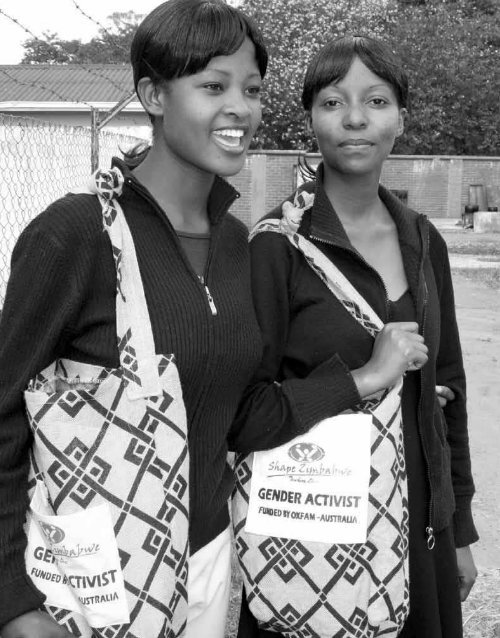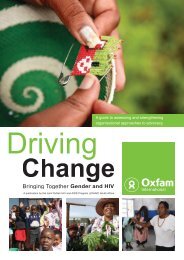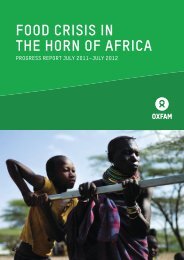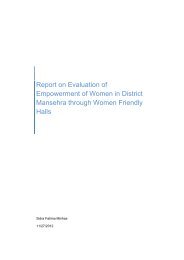shape - Oxfam
shape - Oxfam
shape - Oxfam
You also want an ePaper? Increase the reach of your titles
YUMPU automatically turns print PDFs into web optimized ePapers that Google loves.
YOUNG PEOPLE AND<br />
HIV IN ZIMBABWE<br />
Zimbabwe has the fifth-highest HIV prevalence in the world,<br />
with one in five adults, or 20.1% of people aged 15–49,<br />
living with HIV. It also has the second lowest life expectancy<br />
in the world – 36 years for women and 37.2 years for men 1<br />
– largely due to the country’s HIV and AIDS epidemics.<br />
But despite these alarming<br />
statistics, Zimbabwe is the<br />
first country in Southern Africa<br />
to show a drop in HIV prevalence,<br />
down from 24.6% of adults in<br />
2003 to 20.1% in 2005 2 .<br />
Young people between the ages<br />
of 15–24 are at greatest risk of<br />
being exposed to HIV. The Joint<br />
United Nations Programme on HIV<br />
and AIDS (UNAIDS) estimates that<br />
this age group accounts for at<br />
least half of all new HIV infections<br />
in sub-Saharan Africa – a figure<br />
which reached 2.8 million in 2006.<br />
In Zimbabwe, government<br />
statistics reveal that 16.2% of<br />
young people aged 15–24 are<br />
living with HIV. Women are most<br />
at risk of being infected, with<br />
18.5% of young women aged<br />
15–24 living with the virus,<br />
compared to 8.9% of young men. 3<br />
UNAIDS knowledge and<br />
behavioural indicators for 2005 4<br />
provide greater insight:<br />
• 45.9% of young women<br />
aged 15–24 and 43.7% of<br />
young men do not know<br />
how to prevent HIV.<br />
• 78.6% of young men had<br />
sex with a casual partner in the<br />
previous 12 months, compared<br />
to 23.3% of young women.<br />
• Of those who engaged in<br />
casual sex, about half (57.4%<br />
of women and 43.5% of men)<br />
did not use condoms.<br />
• 8.5% of young men and<br />
8.1% of young women have<br />
had sex before the age of 15.<br />
Zimbabwe has responded to<br />
the HIV youth crisis in various<br />
ways: by investing in health<br />
and education, establishing<br />
the National AIDS Council and<br />
AIDS Trust Fund and focusing<br />
on behaviour change programs<br />
such as mandatory HIV and AIDS<br />
education in schools, anti-AIDS<br />
clubs, life skills training and peer<br />
education. Unfortunately these<br />
efforts have had little impact<br />
on reducing young people’s<br />
vulnerability to HIV, with infection<br />
rates remaining high.<br />
Many HIV and AIDS programs<br />
targeted at young people fail<br />
because they are based on<br />
the romantic and idealistic<br />
notion of sexual abstinence,<br />
rather than taking into account the<br />
realities of young peoples’s lives.<br />
Many programs:<br />
• tend to be moralistic and to<br />
focus on abstinence-only<br />
messages;<br />
• are often adult-led and do not<br />
actively involve young people<br />
in the design, implementation<br />
and evaluation of activities;<br />
• rely on lectures which<br />
young people find boring<br />
and alienating;<br />
• are rarely designed to help<br />
young people develop the<br />
necessary communication,<br />
negotiation and decisionmaking<br />
skills to protect<br />
themselves from infection; and<br />
• assume that young people<br />
constitute one large<br />
homogenous group which<br />
will benefit equally from<br />
“one-size-fits-all” activities.<br />
OPPOSITE: MSU First year law student<br />
Priviledge Mvundla and second year English<br />
student Belinda Zinyuke with the gender activist<br />
bags they use when speaking with other<br />
students about gender and HIV issues.<br />
Photo: William Nyamuchengwa/<strong>Oxfam</strong>AUS.<br />
4 5








![Download: Faltposter EU-Handelspolitik [PDF 2,17MB] - Germanwatch](https://img.yumpu.com/25095854/1/190x161/download-faltposter-eu-handelspolitik-pdf-217mb-germanwatch.jpg?quality=85)







